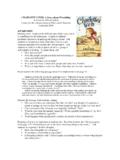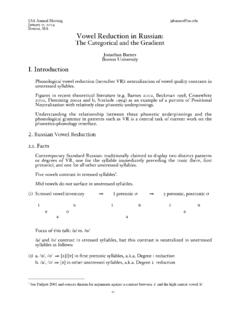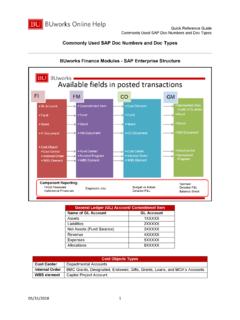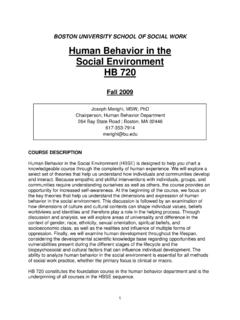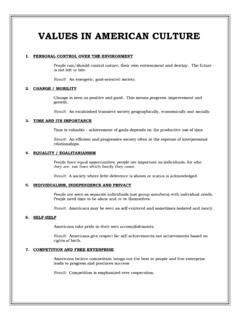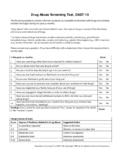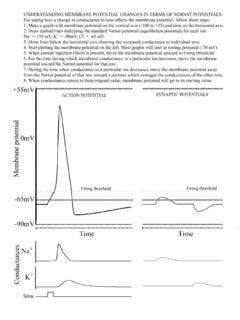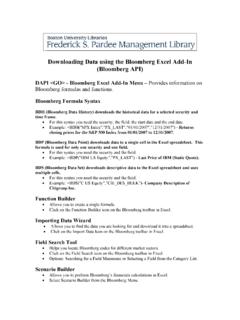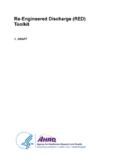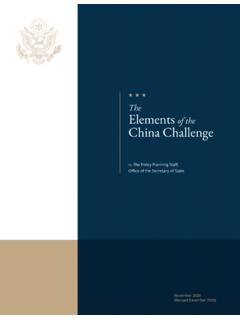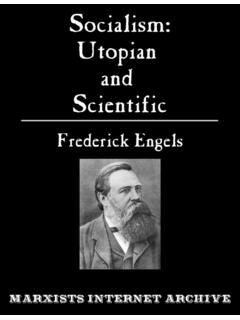Transcription of World War I and the Rise of Fascism in ... - Boston University
1 World War I and the Rise of Fascism in ItalyGianluca Russo First Version: July 30, 2018 Latest Version: May 12, 2020 AbstractOne of the key steps that allowed Mussolini to become the ItalianDucewas the victoryin the 1924 national elections. I study the impact of World War I on Mussolini selectoral success. I reconstruct the military death rate for the universe of Italianmunicipalities, which is matched to municipal level voting in the 1924 election. Aftercontrolling for the number of individuals drafted in a municipality, the variation in theshare of fatalities is caused by military events exogenous to municipality characteristicsthat could simultaneously affect support for Fascism . I find that a higher share offatalities increases the vote share for Fascism . In particular, the vote share for Fascismis higher in municipalities with both higher fatality ratesanda greater number ofveterans returning from the frontline.
2 I show that the effect of WWI deaths is drivenby municipalities that in 1921 had above median vote shares for the Socialist is consistent with the historical narrative that the initial rise of Mussolini wasfacilitated by thered menace: the threat of a Socialist revolution in : Political Economy, Fascism , War Classification: D72, P16, N44. Boston University , Economics Department. Bob Margo, James Feigenbaum andDaniele Paserman provided excellent guidance throughout this project. For useful conversations I would alsolike to thank Sam Bazzi, Leah Boustan, Martin Fiszbein, Stefano Gagliarducci, Giacomo Gabbuti, ChristophKoenig, Pascual Restrepo, Nico Voigtlander, Marco Tabellini, participants at the 2018 Economic HistoryLunch Seminar at Harvard, participants of the Micro Dissertation Workshop at BU, participants of the 2018 WEHC and participants of the 2018 ASE workshop. I would also like to thank Amos Conti and ISTORECOfor maintaining and sharing the data on WWI IntroductionThe past decade has seen the steep rise of authoritarianism and populism around the the two do not always come together, we increasingly see parties use populist argu-ments to gain power, and once in office, dismantle the checks and balances of liberal the well-documented positive impact of democracy on economic growth (Acemogluet al.)
3 2019; Papaioannou and Siourounis 2008), the risk of new authoritarian regimes posesa threat to human development. Understanding the roots of non- democratic regimes andwhat conditions cause their rise is a crucial step towards avoiding their common practice among authoritarian leaders is to generate or exploit social instabilityto call for the suspension of the democratic institutions. This is often achieved through thecreation of external threats, real or perceived, that justify increased executive power andthe reduction of political offers multiple occurrences to exemplify thispattern. The poster child is the rise of Fascism in the early twentieth century when BenitoMussolini and Adolf Hitler leveraged the instability that followed the end of World War One(WWI) to seize power in Europe. While the link between the WWI aftermath and the riseof Fascism in Europe has been largely documented by historians, we have little quantitativeevidence.
4 In economics, beyond limited literature on Germany, scholars have neglected theItalian this paper, I explore the consequences of WWI for the rise of Fascism in Italy. I showthat the instability fueled by WWI led to larger electoral consensus for Mussolini s coalitionin 1924. To measure the instability caused by the conflict, I rely on military death rates forthe universe of Italian municipalities. There is no question over the salience of this measure1A recent example is Hungary, where Prime Minister Viktor Orban has exploited the Covid-19 crise tosuspend parliament and all future the economics literature on Italian Fascism is practically non-existent, some scholars have inves-tigated the rise of Hitler (Adena et al. 2015; Galofr e-Vil`a et al. 2017; Voigtl ander and Voth 2014; Satyanathet al. 2017; Jorg and Philipp 2017; De Bromhead et al. 2013). Koenig (2015) is the only one focusing onWWI. He investigates whether the presence of WWI veterans had a positive impact on the rise of Nazismin the early 1930s and finds link between veterans and a separate right wing party that indirectly facilitatedthe rise of Hitler to the Italian population or the Fascist party.
5 World War One was the first large scalemilitary conflict for modern Italy and as such mobilized the entire country, with very fewmunicipalities experiencing no rise of Mussolini offers a great setting to study the determinants of authoritarian-ism. The circumstances among which Benito Mussolini rose to Italian dictator delineatesimilar patterns to those we observe today. Mussolini became prime minister amidst theredbiennium, a period characterized by great instability and when Italy was on the verge ofa Socialist revolution. Many historians have documented the importance that the externalthreat of the so calledred menaceto foster consensus around the Fascist leader (Lyttelton1973; De Felice 1965).Also the political orientation of the Fascist party resembles those of populist parties Fascist propaganda exploited the profound sense of dissatisfaction stemmed from WWIto generate rhetoric was part of a larger effort to discredit the political eliteand accuse it to be unable to meet the greatness of Italy s fate (Scurati 2018).
6 Much alikemodern populists, Mussolini s political agenda was vague and mostly defined by a stronganti-establishment identity: The fascist movement is not a party of programs, it is a partyof action (Scurati 2018).To study the link between war fatalities and Fascism , I construct a novel dataset linkingmilitary death rates and postwar electoral results. I compute the number of deaths collaps-ing at the municipality level individual records from the WWI honor list (ProvveditoratoGenerale dello Stato 1926). To reconstruct the military death rates, I divide the fatalitycount by the number of conscripts. I measure electoral consensus for Mussolini using voteshares obtained by the Fascist coalition during the 1924 national elections, the first postwarelection where Mussolini ran as head of the coalition. I also trace the effect of the war onother political parties and use 1921 electoral shares for the Socialist party to quantify the3 The poet Gabriele D annunzio coined the mottoVittoria Mutilata(mutilated victory) to express that,despite the winning the war, the rewards did not match the large costs.
7 Although he never got officiallyinvolved with the Fascist party, he had a long-lasting influence on Benito Mussolini and the first steps of theFascist for the socialism before the rise of identification strategy assumes that conditional on the number of men drafted in agiven municipality, variation in military death rates is determined by military events on thefrontline, exogenous to unobservable characteristics that could also affect the rise of Mussoliniin the aftermath of the conflict. Historical recounts of the war and further robustness checksbased on pre-war outcomes validate the plausibility of this main result of the paper is that municipalities which experienced higher death ratesin WWI, were more likely to vote for the Fascist coalition in the 1924 national ten percentage points increase in the fatality rate is associated with a three percentagepoints increase in vote shares for Mussolini. The marginal effect represents a five percentincrease over the average vote share for the Fascist paint a fuller picture on the effect of military deaths on post-WWI political outcomes,I investigate the impact of the war on the vote shares for the Socialist and Catholic party,the main rivals of the Fascist party.
8 While the Fascist party gains from the increase in wardeath, the Socialist party is the main loser. A ten percentage points increase in the fatalityrate is associated with a percentage points reduction in the vote share for the Socialists,slightly more than half of the increase I find for the Fascist coalition. Military death rateshad no effect on the consensus for the Catholic informative value of electoral data close to dictatorships should not be interpretedwith caution. Historians have highlighted the presence of electoral frauds in the years follow-ing the war (De Felice 1965). I argue that differences in vote shares between municipalities not the overall level of consensus are still informative of differences in consensus forthe Fascist party. I investigate the effect of death rates on turnout to provide evidence thatelectoral fraud at the local level, such as overstuffing boxes with fake votes for Fascism , didnot systematically correlate with higher war deaths.
9 In fact, I find that larger military deathrates were responsible for the reduction in the turnout share, most likely due to the deathof men in voting age during the have also pointed out that veterans returning from the frontline might havebeen a ripe basis for the rising Fascist movement. The militaristic organization and therhetoric of themutilated victoryresonated strongly with veterans that had a hard timereintegrating in the postwar civil life. Hence, I investigate if the effect of WWI fatalitiesis larger in municipalities with a higher density of veterans. I am unable to include bothfatalities and veterans after controlling for the number of individuals drafted as they wouldbe collinear. Thus, I look at the marginal effect of fatalities between low, medium and hightreated municipalities. If the effect of fatalities interacts with veterans, I should observe thatthe effect is driven by the municipalities in the middle of the find suggestive evidence that the effect of WWI fatalities follows an inverted U-shape,consistent with the complementarity of fatalities and veterans: the role of military deathrates is maximized when both fatalities and veterans are present in sufficient number in amunicipality.
10 The effects are smaller for municipalities with few fatalities and many veteransor vice versa in municipalities with many fatalities and few veterans. I interpret this resultas follows. On the one hand, for municipalities with low fatality rates, war did not havea brutalizing effect because most of drafted men made it home alive. On the other hand,in municipalities with high fatality rates, the number of veterans was too small to generateenough density to provide a ripe basis to the fascist movement. Only in municipalities whereboth fatalities and veterans were dense enough, did the sorrow from the losses in WWIinteract positively with the anger of the veterans back from the did WWI military death rates affect the electoral consensus for Mussolini? Oneof the most influential historical hypotheses on the rise of Fascism in Italy argues thatthe political and economic instability that followed WWI increased the vote shares for theSocialist and Communist party (Lyttelton 1973; De Felice 1965).
